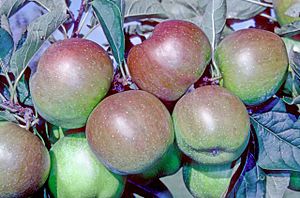Wagener (apple) facts for kids
Quick facts for kids Wagener |
|
|---|---|
 |
|
| Cultivar | 'Wagener' |
| Origin | Penn Yan, New York, United States, around 1791 |
The Wagener apple is a type of apple that was first grown a long time ago in New York, United States. It's also known as Wagener Price or Wagoner. This apple was once very popular, but you don't see it grown as much today. It's even a parent to another apple called the Idared!
Contents
A Look Back: The Wagener Apple's Story
The Wagener apple has an interesting history! It all started in 1791 in Penn Yan, New York. A person named George Wheeler began a small farm there, planting apple seeds he brought from Dutchess County, New York.
In 1795, Abraham Wagener bought this farm. He planted the apple trees on his own land. The apple was named after him, becoming the "Wagener" apple.
The apple became famous in 1847. The New York State Agricultural Society officially recognized it. After this, farmers across the United States started growing many Wagener apple trees. Later, in 1910, the apple traveled across the ocean to England. There, it even won an Award of Merit from the Royal Horticultural Society!
What Does a Wagener Apple Look Like?
The Wagener is a medium-sized apple. It often has a slightly flat or uneven shape. Its skin is mostly red, with bright yellow spots near the top.
When you cut it open, the inside is white or a light cream color. The flesh is very crisp and fine-grained. It's also tender, meaning it's easy to bite into. The taste is a mix of sweet and tart, which makes it quite refreshing!
Growing Wagener Apples
Wagener apple trees grow quickly. They also start producing fruit early in their life. This was a big reason why farmers liked them so much. They could get apples from their orchards sooner!
However, these trees can sometimes grow too many apples. If there are too many apples on a branch, they can become crowded. This might lead to smaller or lower-quality fruit. To keep the trees healthy and the apples tasty, farmers need to prune the branches. They also thin out the developing fruit, removing some so the others can grow bigger and better.
See also
 In Spanish: Wagener (manzana) para niños
In Spanish: Wagener (manzana) para niños

